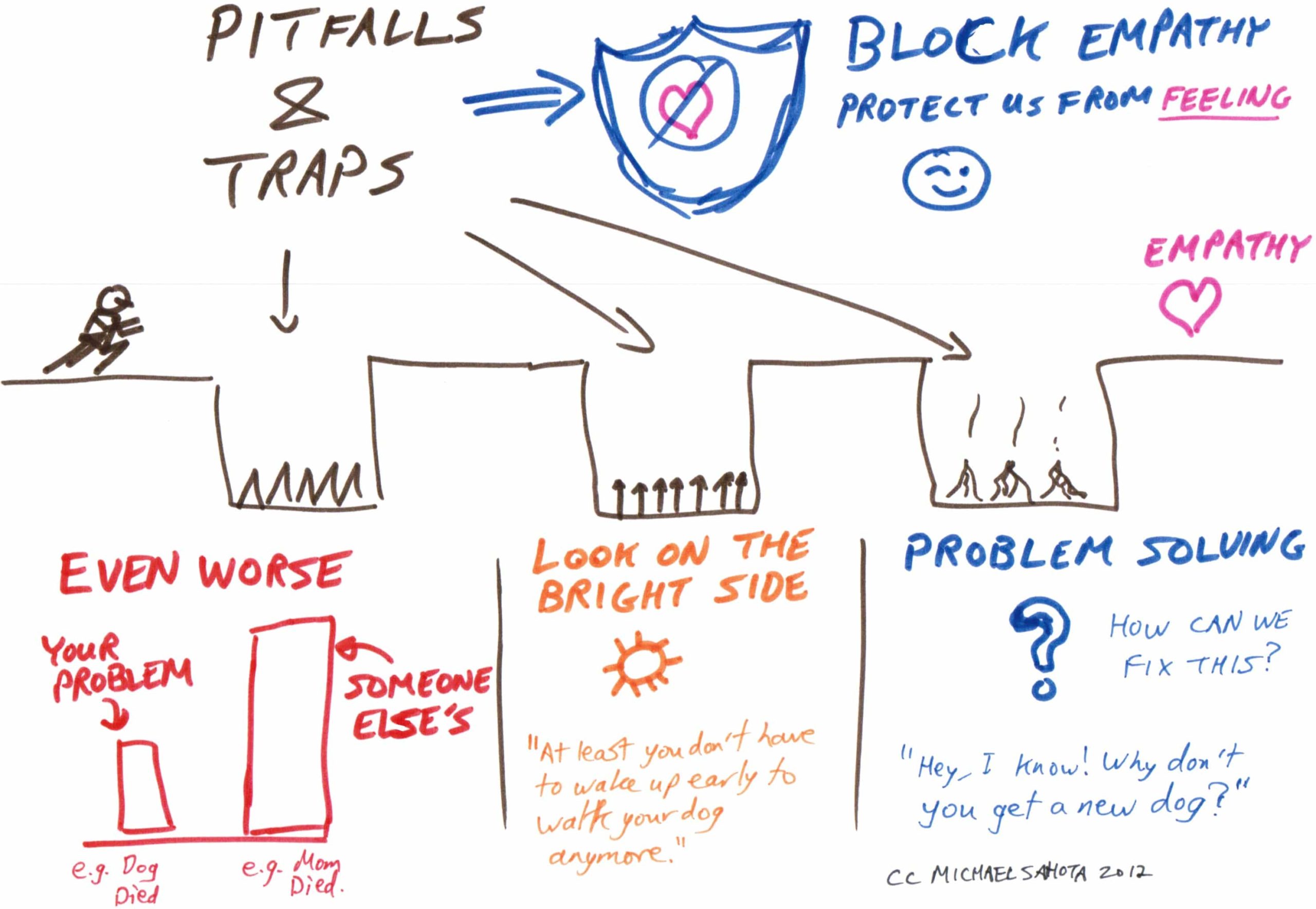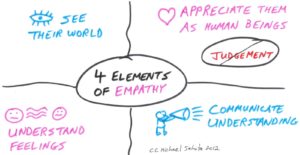It was the Fall of 2011 and I began to cry as I was reading Brene Brown’s book I thought it was just me. I discovered that at age 42 I was unable to express empathy. This came as a huge shock.
In this post you will learn the common empathy traps that we tend to fall in. Once you know the how to avoid the pitfalls, you’ll be ready to start building your emotional muscles. Fortunately for us, awareness and a little practice goes a long way to improving empathy.
Why care about empathy?
The practice of empathy builds trust and increases safety in your family and work environments. It supports the social fabric required for communication and shared activities. A world with empathy is nurturing and supportive – it creates an environment where people can be creative and take risks.
Empathy Traps (Anti-patterns)
Most of us have a basic understanding of how to express empathy.
The HUGE PROBLEM is that we are really good at BLOCKING EMPATHY to protect ourselves from feeling.
 Imagine someone is in emotional distress. By blocking their emotions from our reality, we can avoid acknowledging and connecting to their pain. In the short run, this is great – we avoid pain. In the long run, we destroy the fabric of our relationships and our environments.
Imagine someone is in emotional distress. By blocking their emotions from our reality, we can avoid acknowledging and connecting to their pain. In the short run, this is great – we avoid pain. In the long run, we destroy the fabric of our relationships and our environments.
Three common traps and pitfalls are indicated in the diagram below. I am (sadly) an expert in the use of each one and am still working on being authentic and not running these anti-patterns.
Trap #1: Even Worse – the basic idea here is to compare the person’s problem with someone else’s problem that is even much bigger. On the surface this may seem like we’re helping them: we’re letting them know that their problem is not that substantial and that surely this will help them see how unimportant it really is. What we are really doing is that we are saying that their problem and feelings are invalid or unworthy. Brene calls this “stacking the deck” and give this example from being trumped in cards: “I’ll see your ‘drunk mother’ and raise you a ‘drug-addict sister'”
Trap #2: Look on the Bright Side – in this approach we ask people to focus on the positive outcome of the situation. Remember the saying “Every cloud has a silver lining?” or “The glass isn’t half empty, it’s half full.” While I believe strongly in both of these statements and the related NLP technique of reframing, these have no place whatsoever when seeking to express empathy. When we focus on the positive, rather than acknowledge a person’s feelings, we ignore and dismiss them as unimportant. The net result is that we invalidate the other person. Hint: once someone feels fully heard and supported in their emotion, it maybe it may be appropriate and helpful to help them see the bright side.
Trap #3: Problem Solving – rather than be with the person in an emotion, we immediately jump to problem solving mode: How can we fix this problem? Typically, we start by assuming the person has invited us to solve their problem by telling us about their situation. (Why else would they tell us?) With this trap, we avoid acknowledging or recognizing the emotion and keep it just to the facts of the situation. We discuss how the situation came to be so it can be avoided in the future.
What to do about this?
- Notice when you are running these anti-patterns and STOP TALKING. Saying nothing is much better than falling in these traps. Rewind the conversation if you need to. It’s never too late to go back.
- Be kind to yourself. You are human like the rest of us. You’ve probably been running these patterns for years and years – it’ll take time to get better.
- Take a deep breath and practice your empathy muscles. Yes! You can learn these skills. See below for one way to do this.
Four Elements of Empathy
The following infographic show four elements of empathy as defined by Theresa Wiseman:
These are:
- See their World – to be able to see the world as others see it. This mean that you cognitively understand what they are saying and can see it from their point of view.
- Appreciate them as Human Beings / No-Judgement – to be nonjudgmental. I have restated the original “non-judgmental” in the positive, so it provides an actionable checklist. Judgement is actually another trap. We go into judgement to discount the persons situation so that we can avoid experiencing their pain. For us to express empathy, we need to see the person as a human being – someone who is valuable in their own right. Warning: this can be very difficult to overcome. I have an upcoming post on the “Anatomy of Peace” that will help clarify.
- Understand Feelings – to understand another person’s feelings. We need to get in touch with our emotions in order to truly connect with another person’s feelings. There is lots of brain research on mirror neurons and how we are neurologically wired to relate to other human beings. A common reason to skip this element of empathy is that we don’t have our own emotions sorted out. So, you may need to do some of your own mental housekeeping in order to be in a place where you can acknowledge other people’s feelings.
- Communicate Understanding – to communicate your understanding of that person’s feelings. The final element is that someone feels like they are understood – that they are seen and heard. This part for me has been a real struggle since I often don’t know what to say. Here is a great phrase from Brene Brown that can be used verbatim or as a starting point: “It sounds like you are in a hard place now. Tell me more about it.”
My Experiences with Empathy
It has been a little over a year since I developed a clear intent to increase my practice of empathy.
The good news is that I am much better at it. Over the last year, I have seen many people touched by the simple act of listening and just being there for them. It is so simple and so powerful.
The bad news is that I still struggle at times. I respond without thinking. Or my own feelings or wounds interfere with my ability to see someone else as a valuable human being. Continued and persistent success with empathy requires higher levels awareness of ourselves as well as healing of past trauma.
The ugly news for us a society is that the empathy deficit is very large. I have noticed that it is commonplace for people to avoid emotions and empathy altogether. Many are lacking empathy skills and, far worse, not even aware that they are missing.
I encourage you to make a difference in the world. Practice empathy on your own and tell others about how they can too.
Acknowledgements
I am deeply grateful to Brene Brown for creating such a wonderful book – I thought it was just me (but it isn’t) – it has helped me in so many ways. The subtitle of the book is “Women Reclaiming Power and Courage in a Culture of Shame”, but men are in just as desperate need for reclaiming empathy and courage in a culture of shame.
Thanks to my dear friend Olaf Lewitz who suggested I read Brene’s book which has launched me on a tidal wave of change. I would also like to thank Pierre Lagacé and my “Gifts of Imperfection” meetup group for a chance practice empathy.
Update 2020: What I Learned Since I wrote The Original Post
As I look back on this work, I realize the most important part of growth is not just learning what good looks like but learning how to identify the traps and challenges that often go without notice.
The other, perhaps more profound learning is that empathy is “table stakes” or a basic requirement for human relationships. I have learned that it is an effective steppingstone to start the journey towards compassion.
The journey for me has been to walk through my own darkness so that I am comfortable with myself. It is only from that place, that I can be comfortable with the darkness, the challenge, the hurt in others. I find I no longer need to block my feelings and experience a genuine response of care for others when they are in suffering. For me today, crying is not a shock, it’s a happening that is welcome. Empathy is a way of being, I have an ability to hold a person, without expectations or trying to do it “right”. My heart is more open to express authentic connection.
To quote Nickelback:
“If everyone cared and nobody cried
If everyone loved and nobody lied
If everyone shared and swallowed their pride
Then we’d see the day when nobody died
… I’m Alive”





